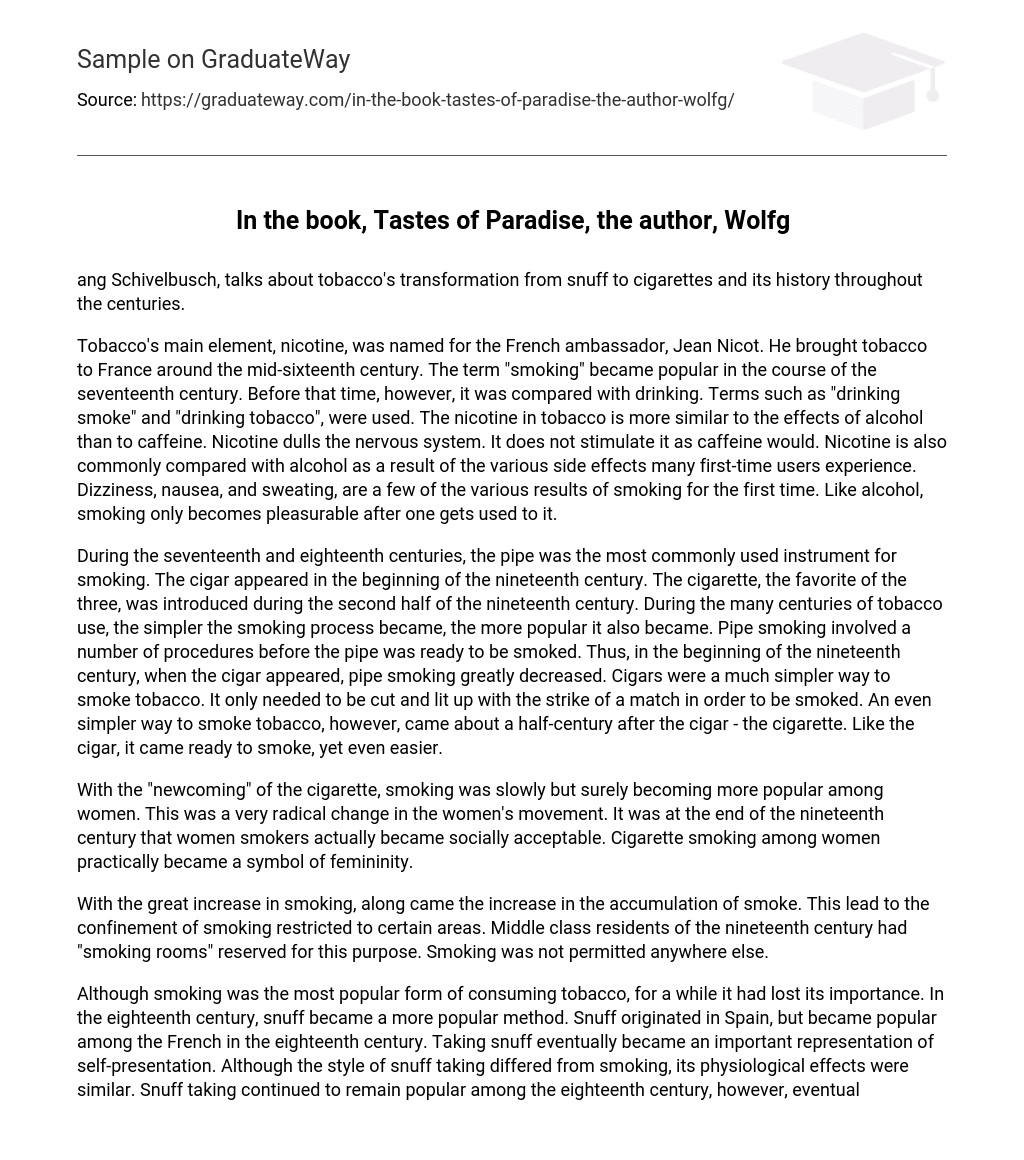In the book, Tastes of Paradise, the author, Wolfgang Schivelbusch, talks about tobacco’s transformation from snuff to cigarettes and its history throughout the centuries.
Tobacco’s main element, nicotine, was named for the French ambassador, Jean Nicot. He brought tobacco to France around the mid-sixteenth century. The term “smoking” became popular in the course of the seventeenth century. Before that time, however, it was compared with drinking. Terms such as “drinking smoke” and “drinking tobacco”, were used. The nicotine in tobacco is more similar to the effects of alcohol than to caffeine. Nicotine dulls the nervous system. It does not stimulate it as caffeine would. Nicotine is also commonly compared with alcohol as a result of the various side effects many first-time users experience. Dizziness, nausea, and sweating, are a few of the various results of smoking for the first time. Like alcohol, smoking only becomes pleasurable after one gets used to it.
During the seventeenth and eighteenth centuries, the pipe was the most commonly used instrument for smoking. The cigar appeared in the beginning of the nineteenth century. The cigarette, the favorite of the three, was introduced during the second half of the nineteenth century. During the many centuries of tobacco use, the simpler the smoking process became, the more popular it also became. Pipe smoking involved a number of procedures before the pipe was ready to be smoked. Thus, in the beginning of the nineteenth century, when the cigar appeared, pipe smoking greatly decreased. Cigars were a much simpler way to smoke tobacco. It only needed to be cut and lit up with the strike of a match in order to be smoked. An even simpler way to smoke tobacco, however, came about a half-century after the cigar – the cigarette. Like the cigar, it came ready to smoke, yet even easier.
With the “newcoming” of the cigarette, smoking was slowly but surely becoming more popular among women. This was a very radical change in the women’s movement. It was at the end of the nineteenth century that women smokers actually became socially acceptable. Cigarette smoking among women practically became a symbol of femininity.
With the great increase in smoking, along came the increase in the accumulation of smoke. This lead to the confinement of smoking restricted to certain areas. Middle class residents of the nineteenth century had “smoking rooms” reserved for this purpose. Smoking was not permitted anywhere else.
Although smoking was the most popular form of consuming tobacco, for a while it had lost its importance. In the eighteenth century, snuff became a more popular method. Snuff originated in Spain, but became popular among the French in the eighteenth century. Taking snuff eventually became an important representation of self-presentation. Although the style of snuff taking differed from smoking, its physiological effects were similar. Snuff taking continued to remain popular among the eighteenth century, however, eventually, losing its popularity over time. Regardless of the many ways tobacco can be consumed, cigarette smoking remained the most popular, much like it is today.
In the book, Drugs in American Society, the author, Erich Goode, mainly discusses more modern day statistics about tobacco. For example, Goode talks about the different types of tobacco consumption, just as Schivelbusch did, however, not in as much detail. Goode discusses the production of cigarettes and the use of cigarettes among different age groups using a wide range of statistical information. Schivelbusch, on the other hand, discusses more historical, factual information about tobacco.
Schivelbusch discussed how certain forms of tobacco consumption played an important role in social status. According to Schivelbusch, snuff taking, “became an important social ceremony; the style with which one handled a snuffbox became a means of self-presentation, of self-display, and of judging others” (131). Goode discusses the importance of socioeconomic in relation to smoking in a different way. According to Goode, “income is correlated negatively or inversely with smoking; 39 percent of low-income males and 33 percent of low-income females smoke; 31 percent of high-income males and 27 percent of high-income females do so” (258). Goode also discusses the effects of education and occupation on smoking.
Although Schivelbusch and Goode both discuss tobacco, they do so in different ways. I found Schivelbusch to be more interesting in his discussion on tobacco, while Goode discusses very important statistical information. I found it more confusing to read Goode’s section on tobacco as a result of the many statistics. However, he did raise an important point that Schivelbusch did not: “Society’s attitudes toward a given drug and its use do not bear a necessary relationship to the drug’s actual properties” (Goode p 259).
I also found it interesting when Schivelbusch mentioned that during the eighteenth century, when smoking became more popular, that smoking rooms were reserved and that smoking was prohibited anywhere else. This made me think of the present time, how, by law, most restaurants in New York City, are not allowed to have any smoking sections.
Overall, I found these reading to be interesting because most people do not realize that tobacco is one of the oldest (legal) drugs that is still as popular as it was centuries ago. It also surprises me, after reading Goode’s section on tobacco, how many people still continue to smoke, when there are so many dangerous side effects that can very easily lead to death. In 1988, the Surgeon General, C. Everett Koop, released his annual report on the consequences of smoking, and stated that nicotine is just as addicting as heroine and cocaine.





